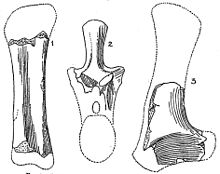| Algoasaurus Temporal range:
Early Cretaceous,
| |
|---|---|

| |
| Femur, vertebra and scapula (holotype) | |
|
Scientific classification
| |
| Domain: | Eukaryota |
| Kingdom: | Animalia |
| Phylum: | Chordata |
| Clade: | Dinosauria |
| Clade: | Saurischia |
| Clade: | † Sauropodomorpha |
| Clade: | † Sauropoda |
| Clade: | † Neosauropoda |
| Genus: | †
Algoasaurus Broom, 1904 |
| Species: | †A. bauri
|
| Binomial name | |
| †Algoasaurus bauri Broom, 1904
| |
Algoasaurus ( /ælˌɡoʊ.əˈsɔːrəs/; " Algoa Bay reptile") is a genus of sauropod dinosaur from the Berriasian- early Valanginian-age Early Cretaceous Upper Kirkwood Formation of Cape Province, South Africa, specifically near a town called Despatch. Only one species, A. bauri, is known. [1] [2]
Discovery and naming
The holotype, a cervical vertebra, femur, an ungual phalanx and a scapula, was recovered in 1903 from a quarry in Despatch, Eastern Cape which exposed part of the Upper Kirkwood Formation [3] by workmen who did not recognize them as dinosaur specimens, so many of the bones, probably including the rest of the once near-complete holotype, were made into bricks and thus destroyed; [1] it is possible that bricks in the Nelson Mandela Bay Metropolitan Municipality may still contain parts of the Algoasaurus holotype. According to Broom (1904), the Port Elizabeth Museum collected "a few fragments of vertebrae and ribs" during another attempt to collect any remaining bones at the site.
The type species, A. bauri, was named by Robert Broom in 1904 and he likened Algoasaurus to Brontosaurus and Diplodocus. [1] Broom gave much of his fossil collection to the American Museum of Natural History in 1913, including the ungual phalanx from the holotype, listed as specimen AMNH FR 5631. [2]
Canudo & Salgado (2003) and Ibiricu et al. (2012) both considered Algoasaurus to have belonged to Rebbachisauridae based on the shape of the neural arch of the cervical vertebra, [4] [5] but MacPhee et al. (2016) disagreed with the rebbachisaurid affinities of Algoasaurus, stating that, although the shape of the vertebra suggests Algoasaurus belonged to Rebbachisauridae, the shape of the scapula says otherwise, so they could not identify Algoasaurus further than Eusauropoda and they also could not locate the rest of the holotype, [3] although they did find specimen SAM-PK-K1500 in the collections of the Iziko Museum in Cape Town to possibly be the lost caudal vertebra pertaining to the holotype or possibly another specimen of Algoasaurus unrelated to the holotype, [3] but SAM-PK-K1500 is yet to be described in detail, so it can not yet be confidently assigned to any genus.
Description
The animal may have been around 9 m (30 ft) long when it died, [6] although this can not be confirmed as the holotype is very fragmentary. Before it was lost, the femur was estimated to have been up to 50 centimetres (20 in) when complete. [1]
Classification
Algoasaurus was a eusauropod; although it has often been assigned to the Titanosauridae, [7] [8] there is no evidence for this, and recent reviews have considered it to be an indeterminate sauropod. [9] [10] It was then believed to have been a member of Rebbachisauridae [4] [5] until it was reclassified in 2016 as an indeterminate eusauropod. [3]
Paleoenvironment
Sedimentological analysis of the holotype assemblage suggests it came from a horizon transitioning into a drier climate. [11] Other animals from the Kirkwood Formation include the iguanodontian Iyuku, the stegosaur Paranthodon, the ornithomimosaur Nqwebasaurus, and several other unnamed dinosaurs.
References
- ^ a b c d Broom, R. (1904). On the occurrence of an opisthocoelian dinosaur (Algoasaurus Bauri) in the Cretaceous beds of South Africa. Geological Magazine, decade 5, 1(483):445-447.
- ^ a b Broom, R. (1915). Catalogue of types and figured specimens of fossil vertebrates in the American Museum of Natural History. II.–Permian, Triassic and Jurassic reptiles of South Africa. Bulletin of the American Museum of Natural History 25(2):105–164.
- ^ a b c d McPhee, Blair W.; Mannion, Philip D.; de Klerk, William J.; Choiniere, Jonah N. (2016). "High diversity in the sauropod dinosaur fauna of the Lower Cretaceous Kirkwood Formation of South Africa: Implications for the Jurassic–Cretaceous transition" (PDF). Cretaceous Research. 59: 228–248. Bibcode: 2016CrRes..59..228M. doi: 10.1016/j.cretres.2015.11.006. ISSN 0195-6671.
- ^ a b Canudo, J. I., and L. Salgado. (2003). Los dinosaurios del Neocomiense (Cretácico Inferior) de la Península Ibérica y Gondwana occidental: implicaciones biogeograficas. Pages 251–268 in F. Pérez-Lorente, editor. Dinosaurios y Otros Reptiles Mesozoicos de España. Instituto de Estudios Riojanos, Logroño, Spain.
- ^ a b Ibiricu, L. M., G. A. Casal, M. C. Lamanna, R. D. Martínez, J. D. Harris, and K. J. Lacovara. (2012). The southernmost records of Rebbachisauridae (Sauropoda: Diplodocoidea), from early Late Cretaceous deposits in central Patagonia. Cretaceous Research 34:220–232.
- ^ Don Lessem; Donald F. Glut (1993). The Dinosaur Society's dinosaur encyclopedia. Tracy Ford (illus.) ... [et al.] ; scientific advisors, Peter Dodson (1st. ed.). New York: Random House. p. 16. ISBN 0-679-41770-2.
- ^ Romer, Alfred Sherwood (1997). Osteology of the reptiles (Reprint with new preface and taxonomic table. ed.). Malabar, Fla.: Krieger Pub. Co. pp. 1–772. ISBN 0-89464-985-X.
- ^ Steel, R. (1970). Saurischia. Handbuch der Paläoherpetologie/Encyclopedia of Paleoherpetology. Part 14. Gustav Fischer Verlag:Stuttgart p. 1-87.
- ^ David B. Weishampel; Peter Dodson; Halszka Osmólska, eds. (1992). The Dinosauria (1st. paperback printing. ed.). Berkeley: University of California Press. pp. 345–401. ISBN 0-520-06727-4.
- ^ David B. Weishampel, ed. (2004). The Dinosauria (2nd. ed.). Berkeley [u.a.]: Univ. of California Press. pp. 259–322. ISBN 0-520-24209-2.
- ^ Forster CA, de Klerk WJ, Poole KE, Chinsamy-Turan A, Roberts EM, Ross CF (2022). "Iyuku raathi, a new iguanodontian dinosaur from the Early Cretaceous Kirkwood Formation, South Africa". The Anatomical Record. 306 (7): 1762–1803. doi: 10.1002/ar.25038. PMID 35860957. S2CID 250730794.











